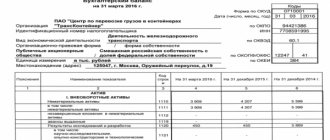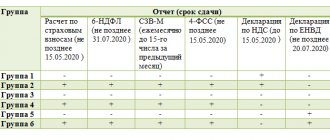Any enterprise and any organization needs a tool that allows you to keep track of money and business transactions. A modern solution to these issues is accounting reporting, which allows you to obtain reports on the financial and property position of an organization for a specific reporting period. After reading this article, it will become clear what accounting financial statements are, who should maintain them, what forms and forms of accounting exist, and in what form it should be drawn up.
Features of preparing financial statements for individual entrepreneurs and LLCs
The peculiarity of drawing up a BO by an individual entrepreneur is that its content and volume depend on:
- number of employees;
- tax regime.
In the case when an individual entrepreneur works for the simplified tax system, he does not have to do accounting at all. This means that he does not constitute a BO.
LLCs that also use the simplified tax system have the right to simplified methods of accounting and preparation of financial statements. The forms of reporting documents are approved by Ministry of Finance orders. And although they are less voluminous than for enterprises on OSNO, you need to fill out both a balance sheet and reports on financial results and the intended use of funds.
All other organizations must keep accounting records and prepare financial statements in full. The reports are signed by the individual entrepreneur, the signature must be deciphered and the date when exactly the document was drawn up is indicated. Even if the balance sheet is filled out in a simplified form, the equilibrium rule continues to apply - the amounts for assets and liabilities are absolutely identical.
Important! When an individual entrepreneur begins to develop a business, he invests his own or borrowed funds into it. A correctly drawn up balance sheet, even in a simplified form, will present a complete picture of where they were used and what the financial condition is now.
Deadlines for preparing financial and accounting reports
Legal entities are given three months after its end to prepare financial and accounting statements for the reporting period. According to paragraphs 12 and 13 of Article III of PBU 4/99, the reporting period is equal to one calendar year, and the reporting date is December 31. On this day, all indicators of the organization’s activities are recorded.
Also, standard 4/99 stipulates the need for monthly summing up of the enterprise’s work by drawing up a balance sheet and profit and loss statement. There is no need to submit interim financial statements to government agencies. As a rule, such reporting is required by owners, investors, and when conducting auctions or tenders.
BO forms for enterprises with simplified tax system
For enterprises with simplified taxation system, BO forms are provided in a somewhat simplified form:
- Balance sheet.
- Income statement.
The simplified balance sheet includes:
- data for the previous two years plus the reporting year;
- assets and liabilities in a summarized form.
Example. In a complete balance sheet, the asset consists of two sections. In simplified form - from 5 lines. All components of intangible assets are summarized in one paragraph. The liability includes six lines instead of three sections in the full balance sheet.
The financial results report reflects:
- revenue and other income;
- costs;
- tax and net profit that remains at the disposal of the company.
Information is provided for two years.
Important! If a small enterprise needs additional decoding when compiling a BO, then the simplified form is not suitable for them, since the columns in it are strict.
Composition of financial statements
When preparing financial statements, an organization must be guided by the standard PBU 4/99, which establishes that the final financial and accounting statements consist of:
- Balance sheet;
- Income statement;
- Statement of changes in equity;
- Cash flow statement;
- Report on the intended use of funds;
- Explanations to financial and accounting statements;
- An audit report on the reliability of reporting, if the organization’s activities are subject to mandatory audit.
An important condition is the obligation provided for in paragraph 10 of Article III of PBU 4/99 to provide data for the two previous years in the listed forms. In this case, the data must be comparable, otherwise either correction of the information or detailed explanations is required.
When deciding on the level of detail of reporting items, you need to be guided by the criterion of materiality of indicators established in the company’s accounting policy for the current reporting period.
It is also recommended to pay attention when filling out reporting forms to the fact that within them there are control ratios of various indicators. Their correctness signals to the inspection authorities that the company’s reporting, including tax returns, has been compiled without distortion. If the control ratios are not met, the tax authorities will request explanations about the identified discrepancies.
The example shows the relationship between balance sheet items and the property tax return:
Providing financial statements in electronic form
BO, like tax reporting, can be provided in the form:
- Paper.
- Electronic.
The first method involves mailing or personally delivering all completed reports on paper pages. Read also the article: → “Reporting of individual entrepreneurs on UTII without employees in 2021”
BO online is provided:
- Through the EDF operator via TCS - telecommunication channels. They represent a system through which you can send both tax and accounting reports, bypassing their reflection on paper.
This method has many advantages, although there are some disadvantages:
| TKS | |
| pros | Minuses |
| There is no need to visit tax officials, since reports can be sent from the office at a convenient time. This means saving time and nerves | It is necessary to prepare an electronic signature, strengthened and qualified |
| There is no need to fill out paper BO samples | Have high-speed Internet and virus protection |
| The number of technical errors is reduced to zero, since the program warns about them in a timely manner and monitors the consistency of the results | Install and maintain a special access program |
| Prompt updating of the BO format in the event of the introduction of new forms. It is possible to update the version, which is very easy to do | |
| Guaranteed delivery BO. A confirmation is sent within 24 hours. You can always view your personal card online. No need to wait for a reconciliation report | |
| BO is protected from adjustments or familiarization with unauthorized persons | |
| You can always receive a list of BOs, explanations, or leave a request regarding specific professional information in electronic form. | |
- Through the Federal Tax Service website.
To access the site you need:
- register and get an ID;
- install a special program on your PC;
- obtain a Certificate regarding the public key of the personal signature (chief accountant and manager);
- install a special root certificate of the Federal Tax Service of the Russian Federation, as well as a list of already revoked certificates.
You can't do it without a PC specialist.
This method has the same advantages and disadvantages as the previous one.
- Use one of the services for sending reports online.
Choosing an online reporting service
The Internet is filled with offers to use services that will ensure proper record keeping and timely sending of financial statements.
The table contains data on several of them:
| Criteria | Service | ||
| Partner and K | My business | Elbe | |
| Registration of individual entrepreneurs | – | + | + |
| Interface design and ease of use | – | + | + |
| Drawing up BO | – | + | + |
| Delivery of BO | paid | paid | for free |
| Consultation with specialists | + | + (free) | + |
| Total annual cost | From 3500 rub. | From 4000 rub. | From 2000 rub. |
Drawing up a BO is not an easy and responsible job. The ability to submit it via the Internet, using high-quality services, greatly facilitates the work of entrepreneurs and accountants.
Formation conditions
- The performance indicators of the branches are mandatory included in the general reporting.
- Reporting is submitted to the tax authorities on paper or electronic media.
- Reliable information about all property, as well as financial condition, is indicated.
- Compilation is carried out in Russian, the currency of settlements is the ruble.
- There should be no contradictions between transactions and accounting.
- Completeness and accuracy of the entered data is required.
If reporting is sent to the tax authority electronically via secure communication channels, to prevent documents from not being received by the addressee, duplicate them on paper or contact the recipient directly.
Find out how to choose a tax system for individual entrepreneurs.
Greenhouse business plan – what needs to be taken into account?Features of a clothing store business plan: read here.
How should financial statements be presented for 2021?
Changes have been made to the reporting procedure due to the introduction of GIR BO.
Accounting reports need to be submitted only to the tax office
Starting from reporting for 2021, you no longer need to submit your balance sheet separately to the tax office and separately to statistics. In accordance with the order of the Federal Tax Service of Russia No. dated November 13, 2021, a mandatory copy of the balance sheet must be submitted only to the Federal Tax Service.
Only small businesses will be able to provide paper reporting
For 2021, only small businesses will be able to report on paper. They are allowed to submit financial statements on paper or via the Internet at their choice.
Organizations that are not small businesses are required to submit reports for 2021 electronically. Electronic reporting formats were approved by Order of the Federal Tax Service of Russia dated November 13, 2021 No. ММВ-7-1/ [email protected]
Important to consider!
Already next year, starting with reporting for 2021, even small businesses will be prohibited from submitting reports on paper. There will be only one delivery format left - electronic via the Internet.
Electronic balance is equal to paper balance
As of reporting for 2021, the electronic balance is equal to the balance drawn up and signed on paper. Now the head of the company can sign a balance sheet printed on paper, or certify an electronic balance sheet with an electronic signature.
Previously, it was believed that the company's balance sheet was drawn up only after the manager signed it on paper. The accounting department was required to keep a paper copy of the balance sheet with the signature of the director (Federal Law of November 28, 2021 No. 444-FZ).
When do financial statements need to be submitted?
Accounting statements are provided within three months after the end of the reporting period.
If the reporting is subject to a mandatory audit, the auditor's report is presented in electronic format along with the reporting (or within 10 working days after the date of its signing by the auditors). The deadline for submission is December 31 of the year following the reporting year.
Updated financial statements can be submitted no later than 10 working days from the day following the day of correction or the day of approval of the annual statements. LLCs provide reporting within 10 working days after April 30, JSC - 10 working days after June 30.
According to 247-FZ of July 26, 2021, if changes are made to the statements, they are taken into account in the financial statements of the next period (Federal Law of July 26, 2021 No. 247-FZ).
Preparation of annual and quarterly reports
Compiling statements is the responsibility of accountants of non-profit and commercial organizations. The purpose of this work is to analyze the company’s activities. Accounting reporting allows you to identify areas that affect the development of the organization, the unprofitability and profitability of financial and economic activities, as well as the correct use of resources and inventory items.
Quarterly reporting (PFR, tax, financial), like annual reporting, is mandatory and has a certain format. It is drawn up and submitted within the time limits determined by current legislation.
Forms of annual and quarterly reporting
Quarterly reporting forms are available to taxpayers in electronic and paper form. The first ones are used in the EDI format. The latter are available for download on the official resources of regulatory organizations. It should be noted that the forms in the latest edition must be used for sending to authorities. Changes must be constantly monitored.
Annual reporting forms are also regulated by regulatory documents. They can be transmitted to regulatory organizations in electronic form and in standard printed form.
Quarterly and annual reporting can be standard or zero. The first displays the company's performance for the reporting period. Quarterly zero reporting is compiled and transmitted to the authorities in the event that the organization does not actually carry out financial and economic activities (there are no account transactions, movement of funds, etc. in the reporting period), but has not stopped it legally (not removed from the Unified State Register of Legal Entities) . The same goes for annual reports with zero figures.
The composition of quarterly reporting may vary. It is determined taking into account the tax regime used by the organization, the specifics of its activities, the organizational and legal form of the legal entity, and other relevant factors. The same applies to the content of the annual reports.
The general composition of financial statements includes:
- balance sheet of the established form;
- balance sheet appendix;
- reports (on the flow of funds, profits, losses, changes in capital, intended use of funds);
- explanatory notes.
Also, with the annual reporting, an audit report is submitted to the state control authorities. This rule is relevant for legal entities that are subject to mandatory audit.
Interim reporting (quarterly) is usually represented by a balance sheet and a report on the organization's performance for a specific period.
Features of preparing annual and quarterly reports
When preparing reports, quarterly and annual, it is important to use up-to-date accounting data. This is mandatory. Errors in reports can lead to serious sanctions against the taxpayer from the Federal Tax Service and other regulatory organizations.
As for the correction of errors, this is possible in the manner prescribed by current legislation. It should be noted that errors in reports have a statute of limitations. After a certain time, making changes becomes impossible.
Is the issue of competent preparation of quarterly and annual reporting, timely submission of reporting documents to regulatory government organizations relevant? A rational solution would be to outsource this function. offers ]accounting support for business[/anchor], including the generation and submission of reports. The professionalism of specialists and work experience guarantee the quality of the result.
The procedure for forming the quarterly balance sheet of an organization
The balance sheet of an organization is the most important form of reporting. This report demonstrates the structure and composition of all assets of the enterprise (property and inventory) and all liabilities, that is, the sources of existing property. To form a quarterly balance sheet, the accountant, first of all, creates a balance sheet for the quarter for which the balance sheet should be formed.
Such a balance sheet is a register that indicates:
- debit and credit balances of all accounting accounts at the beginning of the quarter;
- debit and credit turnover of all accounting accounts for the reporting quarter;
- debit and credit balances of all accounting accounts at the end of the quarter.
All debit and credit turnovers in the balance sheet must be equal to each other. If such equality is not observed, the accountant checks the turnover for each accounting account, which is reflected in the balance sheet.
Need advice from a teacher in this subject area? Ask a question to the teacher and get an answer in 15 minutes! Ask a Question
Based on the balance at the beginning of the quarter, the accountant reconciles the previously submitted balance sheet (for the previous period). If all the data agrees, then the accountant begins to group the data by account balances at the end of the quarter and distribute them among the balance sheet lines.
So, as a rule, the debit balances of accounts form the asset of the balance sheet, and the credit balances of the accounts form the liability part of the balance sheet. For example, the debit balances of accounts 10, 41 form the “Inventories” line in the asset, and the credit balances of accounts 60, 76 form the “Accounts Payable” line.
However, there are some exceptions. For example, the indicator of retained earnings is reflected in the credit of account 84 and in the liability line of the balance sheet of the same name. If, based on the results of the quarter, the organization operated at a loss, such a loss is reflected in the debit of account 84 and in the liabilities side of the balance sheet such an indicator is indicated with a minus sign, or in parentheses.







